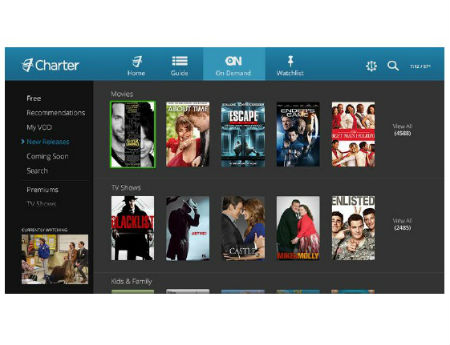Charter Inches Toward Cloud UI Rollout

Charter Communications continues to test a new cloud-based user interface in employee homes, and expects to start expanding it to customer homes in “certain markets” by mid-year as the MSO moves ahead with its ambitious all-digital upgrade plan.
Working in tandem with vendors such as ActiveVideo and Zodiac Interactive, Charter is designing and architecting the new UI (a sample is presented above) so it can be offered across its entire base of set-top boxes, including new IP-capable devices as well as boxes that can only use QAM/MPEG-based digital transport streams. On the latter example, Charter is testing the scalability of a network-based platform from ActiveVideo that essentially stitches the UI into the MPEG transport stream so it can be rendered by QAM-locked boxes.
“Our new guide has been designed to run on every set-top box we have in the field,” Charter president and CEO Tom Rutledge said on Monday’s first quarter earnings call. He later said that initial tests are showing that the approach works and that Charter will be able to extend the UI to all boxes without having to buy new ones.
The new guide is coming into play as Charter moves ahead with all-digital upgrades that will be tied to a new consume brand, Charter Spectrum, and the introduction of a beefed up menu of services.
Rutledge said about 40% of the all-digital plan is complete and that the company is on target to finish the rollout by year end. That completion target includes Charter’s current footprint, and not additions that are poised to come way via a deal announced Monday with Comcast that will involve the exchange of nearly 4 million subs and essentially double the size of Charter’s subscriber footprint.
Charter has already introduced the new Spectrum brand in two markets: Dallas/Ft. Worth and Greenville, S.C.
Tied in with the upgrade and new brand, Charter is launching new service packages, expanding its HDTV lineup to more than 200 channels, adding enhancements to its digital voice service, beefing up its VOD library, and offering 60 Mbps (downstream) as the minimum speed offered on its high-speed Internet product. In St. Louis, Charter has plans to make 100 Mbps as the minimum speed offered in the downstream direction, Rutledge said.
The smarter way to stay on top of the multichannel video marketplace. Sign up below.
Charter’s all-digital plan includes the deployment of two-way interactive set-tops at every outlet, and that decision did contribute to higher capital expenditures in the quarter.
Charter said capex increased $116 million in the quarter year-on-year, to $539 million, with $119 million going toward the all-digital upgrade, and $59 million heading toward commercial services. Charter’s spend on set-tops and other consumer premises equipment also rose by $89 million year-on-year in support of the all-digital effort and other customer growth. For all of 2014, Charter expects capex to hit $2.2 billion, including labor, with $400 million earmarked for the all-digital project.
Despite the rise in capex, Rutledge said overall “capital intensity” on set-top box costs is coming down, citing Charter’s current deployment of integrated security boxes and its work toward a downloadable security platform. “As a result of that -- both the volume and the technology platform that we’re deploying -- our costs per digitally-deployed box is going down,” Rutledge said.
